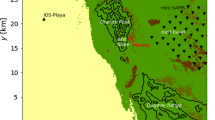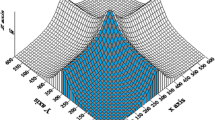Summary
Numerical experiments are performed for inviscid flow past an idealized topography to investigate the formation and development of lee mesolows, mesovortices and mesocyclones. For a nonrotating, low-Froude number flow over a bell-shaped moutain, a pair of mesovortices form on the lee slope move downstream and weaken at later times. The advection speed of the lee vortices is found to be about two-thirds of the basic wind velocity, which is due to the existence of a reversed pressure gradient just upstream of the vortices. The lee vortices do not concur with the upstream stagnation point in time, but rather form at a later time. It is found that a pair of lee vortices form for a flow withFr=0.66, but take a longer time to form than in lower-Froude number flows. Since the lee vortices are formed rather progressively, their formation may be explained by the baroclinically-induced vorticity tilting as the mountain waves become more and more nonlinear.
A stationary mesohigh and mesolow pressure couplet forms across the mountain and is produced in both high and low-Froude number flows. The results of the high Froude number simulations agree well with the classical results predicted by linear, hydrostatic mountain wave theory. It is found that the lee mesolow is not necessarily colocated with the lee vortices. The mesolow is formed by the downslope wind associated with the orographically forced gravity waves through adiabatic warming. The earth's rotation acts to strengthen (weaken) the cyclonic (anticyclonic) vortex and shifts the lee mesolow to the right for an observer facing downstream. The cyclonic vortex then develops into a mesocyclone with the addition of planetary vorticity at later times. For a flow over a steeper mountain, the disturbance is stronger even though the Froude number is kept the same.
For a southwesterly flow past the real topography of Taiwan, there is no stagnation point or lee vortices formed because the impinging angle of the flow is small. A major mesoscale low forms to the southeast of the Central Mountain Range (CMR), while a mesohigh forms upstream. For a westerly flow past Taiwan, a stagnation point forms upstream of the mountain and a pair of vortices form on the lee and move downstream at later times. The cyclonic vortex then develops into a mesocyclone. A mesolow also forms to the southeast of Taiwan. For a northeasterly flow past Taiwan, the mesolow forms to the northwest of the mountain. Similar to flows over idealized topographies, the Taiwan mesolow is formed by the downslope wind associated with mountain waves through adiabatic warming. A conceptual model of the Taiwan southeast mesolow and mesocyclone is proposed.
Similar content being viewed by others
References
Arya, S. P. S., 1988:Introduction to Micrometeorology. San Diego: Academic Press, 303 pp.
Batchelor, G. K., 1967:An Introduction to Fluid Dynamics. Cambridge, Great Britain: Cambridge University Press, 615 pp.
Chen, G. T.-J., 1980: Mesoscale analysis for a Mei-Yu case over Taiwan.Pap. Meteor. Res.,2, 63–74.
Crook, N. A., Clark, T. L., Moncrieff, M. W., 1990: The Dever cyclone. Part I: Generation in low Froude number flow.J. Atmos. Sci.,47, 2725–2742.
Ertel, H., 1942: Ein neuer hydrodynamischer Wirbelsatz.Meteorol. Z.,59, 271–281.
Huang, C.-Y., Raman, S., 1990: Numerical simulations of Taiwan Island circulations: Boundary layer modification. Workshop on TAMEX Scientific Results, pp 194–198.
Hunt, C. R., Snyder, W. H., 1980: Experiments on stably and neutrally stratified flow over a model three-dimensional hill.J. Fluid Mech.,96, 671–704.
Klemp, J. B., Durran, D. R., 1983: An upper boundary condition permitting internal gravity wave radiation in numerical mesoscale models.Mon. Wea. Rev.,111, 430–444.
Kuo, Y.-H., Chen, G. T.-J., 1990: The taiwan area mesoscale experiment (TAMEX): An overview.Bull. Amer. Meteor. Soc.,71, 488–503.
Orianski, I., 1976: A simple boundary condition for unbounded hyperbolic flows.J. Compu. Phys.,21, 251–269.
Queney, P., 1947: Theory of perturbations in stratified currents with applications to airflow over mountain barriers. Dept. of Meteorology, Univ. of Chicago, Misc. Report No. 23.
Rotunno, R., Smolarkiewicz, P. K., 1991: Further results on lee vortices in low-Froude-number flow.J. Atmos. Sci.,48, 2204–2211.
Smith, R. B., 1980: Linear theory of stratified hydrostatic flow past an isolated mountain.Tellus 32, 348–364.
Smith, R. B., 1982: Synoptic observations and theory of orographically disturbed wind and pressure.J. Atmos. Sci.,39, 60–70.
Smith, R. B., 1989a: Hydrostatic airflow over mountains.Adv. Geophys.,31, 1–41.
Smith, R. B., 1989b: Comment on “Low Froude number flow past three-dimensional obstacles. Part I: Baroclinically generated lee vortices”J. Atmos. Sci.,46, 3611–3613.
Smith, R. B., 1989c: Mountain induced stagnation points in hydrostatic flows.Tellus,41A, 270–274.
Smolarkiewicz, P. K., Rasmussen, R., Clark, T. L., 1988: On the dynamics of Hawaiian cloud bands: Island forcing.J. Atmos. Sci.,45, 1872–1905.
Smolarkiewicz, P. K., Rotunno, R., 1989a: Low Froude number flow past three-dimensional obstacles. Part I: Baroclinically generated lee vortices.J. Atmos. Sci.,46, 1154–1164.
Smolarkiewicz, P. K., Rotunno, R., 1989b: Reply.J. Atmos. Sci.,46, 3614–3617.
Smolarkiewicz, P. K., Rotunno, R., 1990: Low Froude number flow past three-dimensional obstacles. Part II: Upwind flow reversal zone.J. Atmos. Sci.,47, 1498–1511.
Sun, W.-Y., Chern, J. D., Wu, C.-C., Hsu, W.-R., 1991: Numerical simulation of mesoscale circulation in Taiwan and surrounding area.Mon. Wea. Rev.,119, 2558–2573.
Szoke, E. J., Weisman, M. L., Weisman, Brown, J. M., Caracena, F., Schlatter, T. W., 1984: A subsynoptic analysis of the Denver tornado of 3 June 1981.Mon. Wea. Rev.,112, 790–808.
TAMEX, 1985: Taiwan Area Mesoscale Experiment: Overview document. NCAR.
Thorsteinsson, S., 1988: Finite amplitude stratified air flow past isolated mountains.Tellus,40A, 220–236.
Tripoli, G. J., Cotton, W. R., 1982: The Colorado State University three-dimensional cloud/mesoscale model-1982. Part I: General theoretical framework and sensitivity experiments.J. de Rech. Atmos.,16, 185–220.
Wang, S.-T., 1989: Observational study of the orographically induced disturbances during TAMEX. Workshop on TAMEX Preliminary Scientific Results, 279–286.
Author information
Authors and Affiliations
Additional information
With 16 Figures
Rights and permissions
About this article
Cite this article
Lin, Y.L., Lin, N.H. & Weglarz, R.P. Numerical modeling studies of lee mesolows, mesovortices and mesocyclones with application to the formation of Taiwan mesolows. Meteorl. Atmos. Phys. 49, 43–67 (1992). https://doi.org/10.1007/BF01025400
Received:
Revised:
Issue Date:
DOI: https://doi.org/10.1007/BF01025400




